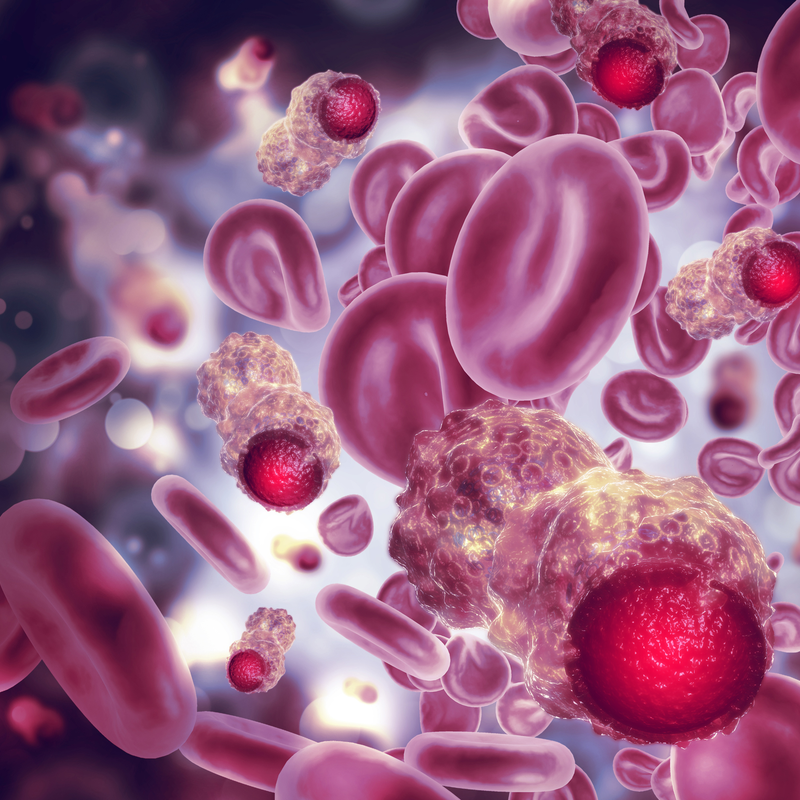
What is a solitary plasmacytoma?
Solitary plasmocytoma is a rather rare variant of multiple myeloma that accounts for about 5 per cent of all plasma cell neoplasms. . Men are usually twice as likely to develop plasmacytoma as women, and it affects African Americans more often than average, and Asians and Pacific Islanders more rarely. The average age at the onset of the disease is between 55 and 65 years. Unlike multiple myeloma, solitary plasmacytoma is confined to a single focus and abnormal plasma cells do not occur throughout the bone marrow.
A solitary plasmocytoma, also known simply as plasmocytoma, describes a plasma cell disease, which is characterised by the formation of a single bone tumour . In most cases, a plasmacytoma forms in a bone along the spine. However, it can also form in the pelvis, ribs, upper extremities, face, skull and femur or sternum. Since the site of formation of the tumour usually corresponds to the position where the abnormal plasma cell formed in the bone marrow, plasmacytomas are curable in 50 percent of all cases.
How does a plasmocytoma develop?
A plasmacytoma is caused by a single degenerate plasma cell on the inner surface of the bone. This abnormal plasma cell is usually a so-called differentiated B-cell lymphocyte, which forms and spreads in the bone marrow by multiplying identical cell types (cloning). This can lead to the development of a single tumour (plasmocytoma) .
What are the causes for the development of a plasmocytoma?
Although first-degree relatives, such as parents and/or siblings of people with a plasmocytoma have a higher risk of also developing the disease, plasmocytoma cannot be considered a hereditary disease in the narrower sense. The exact causes that contribute to the formation of a plasmocytoma are still unknown. Although it is known that the degeneration of a single plasma cell contributes to the formation of a plasmacytoma, it is unclear why this plasma cell degenerates. However, medical experts assume that contact with ionising radiation, bezol and/or pesticides can promote the development of the disease. Likewise, obesity (adiposity) and/or chronic infections can cause the development of a plasmocytoma.
What are the symptoms of a plasmocytoma?
A plasmocytoma usually makes itself felt through immediate pain at the tumour site. This discomfort can be explained by the destruction of the bones that has occurred as a result of the invading plasma cells .
In addition, some patients may also develop a fracture at the tumour site. Especially patients with compression fractures in the vertebral region complain of frequently occurring severe spasms as well as back pain.
How is a plasmocytoma diagnosed?
The confirmed diagnosis of a plasmocytoma is made by means of a biopsy, in which a tissue sample is taken and analysed in the laboratory . In addition, other bone or soft tissue involvement is ruled out with the help of other imaging methods. For example, a bone screening, a positron-electron tomography (PET) as well as a computer tomography (CT) or magnetic resonance imaging (MRI) can be used. It is advisable to perform a PET or an MRI of the entire spine and/or the pelvic region to ensure that no abnormal plasma cell tumours are present.
In addition to these examination procedures, a blood and/or urine sample can provide information about whether a plasmacytoma could be present. At least in 30 to 75 percent of all patients, monoclonal proteins are present in the blood or urine if a solitary plasmocytoma is present at the same time . The so-called monoclonal proteins are produced by abnormal plasma cells and can thus indicate a plasmocytoma.
How is a plasmocytoma treated?
For treatment of a plasmocytoma, radiation therapy is used as the primary form of treatment, if possible. Studies have shown that in only 12 percent of all cases in patients who received local radiotherapy did the tumour develop again. In contrast, this percentage was 60 percent in patients whose tumour was not irradiated.
In contrast to other tumour forms, surgery is rarely necessary for a plasmacytoma . Surgery is usually only performed if the tumour has caused structural instabilities or deformities in the bone. After the successful removal of these malformations, in most cases, radiotherapy is then carried out.
So-called adjuvant chemotherapy as an additional or preventive measure for a plasmocytoma is controversial according to studies. While some studies show that no treatment results can be expected from adjuvant chemotherapy, other studies show that adjuvant chemotherapy delays or even prevents the possible further development of the plasmacytoma into multiple myeloma.
What is the follow-up treatment for a plasmacytoma?
It is recommended that patients with a plasmocytoma should have their blood and urine protein levels as well as their creatinine and calcium levels checked every four to six months for one year after treatment. After one year, an annual blood and urine check is usually sufficient . If any irregularities are found, a bone survey by means of a whole-body PET/CT scan and/or an MRI scan of the spine is also useful.
What is the prognosis for a plasmocytoma?
A number of factors play a role in the prognosis of a plasmocytoma. These include, for example, the level of albumin in the blood. On average, patients with a plasmocytoma live for ten years. Almost 75 percent of all those affected live for another five years, while 45 percent are still alive after ten years.
In about 50 to 60 percent of all cases, the solitary plasmacytoma may develop into a multiple myeloma (recurrent form) despite radiotherapy.
